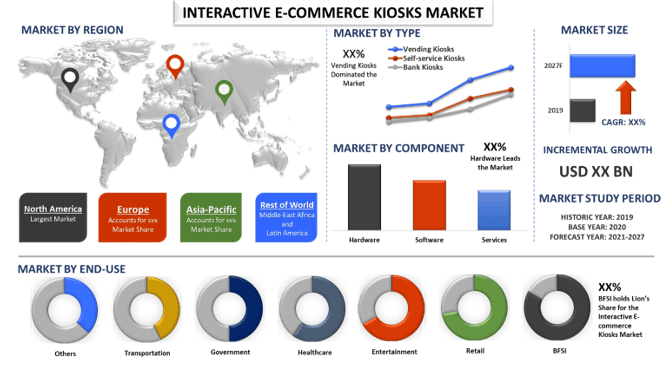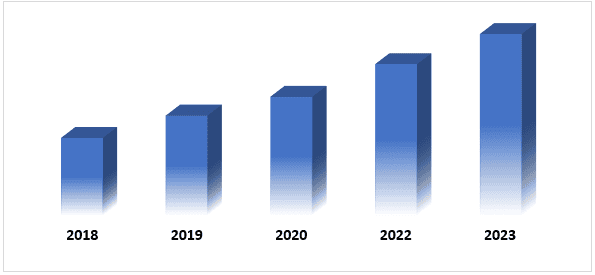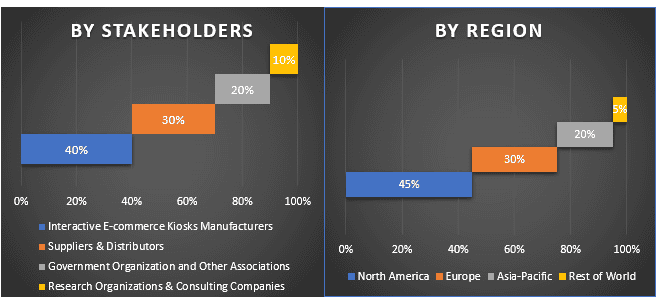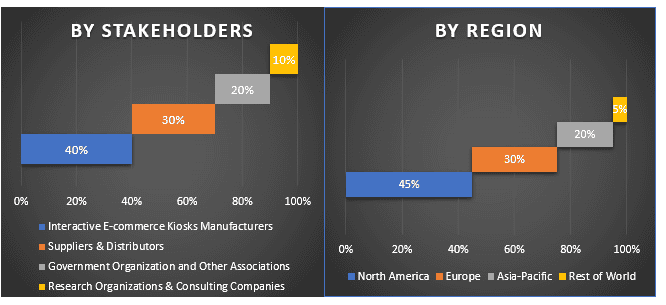- Inicio
- Acerca de nosotros
- Industria
- Servicios
- Leyendo
- Contáctenos
Mercado de quioscos interactivos de comercio electrónico: análisis actual y pronóstico (2021-2027)
Énfasis en el tipo (quioscos bancarios, quioscos de autoservicio, quioscos expendedores); Componente (Hardware, Software, Servicios); Uso final (Minorista, Entretenimiento, Sanidad, BFSI, Gobierno, Transporte, Otros); Región/País

El mercado mundial de quioscos interactivos de comercio electrónico se valoró en 26.200 millones de dólares estadounidenses en 2020 y se prevé que alcance los 36.220 millones de dólares estadounidenses en 2027, lo que muestra una TCAC elevada del 4.8% durante el período de previsión (2021-2027). Un dispositivo de autoservicio desplegado en varios servicios públicos y que ayuda a los usuarios a interactuar con contenido e información digital a través de una interfaz fácil de usar se conoce como quiosco interactivo. Estos se utilizan para ventas al por menor, facturación, orientación, intercambio de información y turismo, etc.
Con el creciente avance de la tecnología en todos los sectores y la demanda de servicios personalizados y eficientes, muchos actores de la industria están cambiando el panorama al involucrar a los clientes con esta tecnología interactiva, lo que a su vez está mejorando la experiencia del cliente. Por ejemplo, un restaurante en China llamado "Yum China Holdings" lanzó un concepto innovador: el concepto de implementar un conjunto de quioscos de pedidos independientes en su tienda que incluyen características como reconocimiento facial y pagos en las pantallas. Además, los quioscos interactivos también están ganando terreno entre las autoridades aeroportuarias debido a la necesidad de reducir las largas colas de facturación y pago. Por lo tanto, impulsando el crecimiento del mercado a nivel mundial.
El crecimiento del mercado de quioscos interactivos de comercio electrónico se puede atribuir al estímulo en el despliegue de ciudades inteligentes e infraestructura inteligente y al aumento de las iniciativas de varias autoridades privadas y gubernamentales para instalar quioscos en áreas públicas. Por ejemplo, en 2021, el Ayuntamiento de Houston aprobó una propuesta para la instalación de casi 125 quioscos digitales en las áreas de Houston, como el centro y la Galleria. Estos quioscos de 8 pies de altura en estas áreas proporcionarán información sobre varios lugares de interés y atracciones locales junto con anuncios. Además de esto, el aumento en el número de consumidores que se inclinan por la adopción de sistemas de autoservicio también está acelerando el mercado interactivo de comercio electrónico a nivel mundial.

Gasto actual y proyectado en tecnología en iniciativas de ciudades inteligentes a nivel mundial, 2018-2023 (en miles de millones de dólares estadounidenses)
NCR Corporation, Diebold Nixdorf AG, KIOSK Information Systems, ZEBRA Technologies Corporation, Emboss Ltd., Meridian Kiosks LLC, Advanced Kiosks, Redyref Interactive Kiosks, Source technologies, SlabbKiosks son algunos de los jugadores prominentes que operan en el mercado de quioscos interactivos de comercio electrónico. Estos actores han emprendido varias fusiones y adquisiciones junto con asociaciones para facilitar a los clientes quioscos nuevos e innovadores.
Perspectivas presentadas en el informe
"Entre los tipos, el segmento de quioscos expendedores tiene la mayor participación"
Según el tipo, el mercado está fragmentado en quioscos bancarios, quioscos de autoservicio y quioscos expendedores. Los quioscos expendedores generaron los mayores ingresos en 2020 y se espera que crezcan notablemente durante el período de pronóstico para liderar el mercado en 2027F debido al aumento de las tiendas minoristas y los restaurantes y hoteles de servicio rápido, ya que esto mejoraría la experiencia de compra de los clientes. Por ejemplo, en los Estados Unidos, Subway, una cadena de sándwiches, era la cadena de restaurantes de servicio rápido líder con 23,801 ubicaciones en todo el país en 2019.
"Entre los componentes, el segmento de hardware tiene la mayor participación"
Según el componente, el mercado está fragmentado en hardware, software y servicios. Se espera que el segmento de hardware obtenga una importante cuota de mercado en 2020 y crezca a una TCAC considerable durante el período de pronóstico (2021-2027). Este segmento incluye pantallas, impresoras, escáneres, sensores, entre otros. El crecimiento de este segmento se atribuye al creciente avance tecnológico y al lanzamiento frecuente de quioscos avanzados. Por ejemplo, en julio de 2021, imageHOLDERS lanzó sus primeros quioscos de autoservicio sin contacto que funcionan con la cámara de seguimiento de manos Ultraleap y el software Ultraleap TouchFree para capturar el movimiento de las manos y los dedos para que puedan interactuar naturalmente con el contenido en pantalla. Debido a esto, ha habido un aumento en la demanda de varios hardware de quioscos a medida que más y más actores de la industria se centran en el lanzamiento de quioscos avanzados innovadores.
"Entre el uso final, el segmento de BFSI tiene la mayor participación"
Según el uso final, el mercado está fragmentado en comercio minorista, entretenimiento, atención médica, BFSI, gobierno, transporte y otros. El segmento BFSI dominó el mercado y se espera que crezca a una TCAC altísima durante el período de pronóstico. El crecimiento de este segmento se atribuye al creciente número de personas que optan por los quioscos de autoservicio, ya que permiten a los consumidores realizar transacciones bancarias a su propia conveniencia sin visitar la sucursal bancaria. Sin embargo, también se espera que el segmento minorista crezca significativamente en los próximos años.
"América del Norte representa uno de los mercados más grandes del mercado de quioscos interactivos de comercio electrónico"
Para una mejor comprensión de la dinámica del mercado de quioscos interactivos de comercio electrónico, se realizó un análisis detallado para diferentes regiones del mundo, incluyendo América del Norte (EE. UU., Canadá y el resto de América del Norte), Europa (Alemania, Francia, España, Reino Unido, Italia y el resto de Europa), Asia-Pacífico (China, Japón, India, Australia y el resto de APAC), se ha llevado a cabo el resto del mundo. América del Norte dominó el mercado y generó ingresos de US$ XX millones en 2020 debido a la creciente adopción de quioscos de autoservicio en las diversas cadenas de alimentación y servicios públicos, incluidos aeropuertos y puertos marítimos. Sin embargo, también se espera que Asia-Pacífico crezca a una TCAC significativa durante el período de tiempo proyectado.
Razones para comprar este informe:
- El estudio incluye un análisis del tamaño del mercado y previsiones validado por expertos clave autenticados de la industria.
- El informe presenta una revisión rápida del rendimiento general de la industria de un vistazo
- El informe cubre un análisis en profundidad de los pares prominentes de la industria con un enfoque principal en las finanzas comerciales clave, la cartera de productos, las estrategias de expansión y los desarrollos recientes.
- Examen detallado de los impulsores, las restricciones, las tendencias clave y las oportunidades que prevalecen en la industria.
- El estudio cubre de manera integral el mercado en diferentes segmentos.
- Análisis profundo a nivel regional de la industria
Opciones de personalización:
El mercado global de quioscos interactivos de comercio electrónico se puede personalizar aún más según los requisitos o cualquier otro segmento de mercado. Además de esto, UMI entiende que puede tener sus propias necesidades comerciales, por lo tanto, no dude en conectarse con nosotros para obtener un informe que se adapte completamente a sus requisitos.
Tabla de contenido
El análisis del mercado histórico, la estimación del mercado actual y la previsión del mercado futuro del mercado mundial de quioscos interactivos de comercio electrónico fueron los tres pasos principales realizados para crear y analizar la adopción de quioscos interactivos de comercio electrónico en las principales regiones del mundo. Se llevó a cabo una exhaustiva investigación secundaria para recopilar las cifras históricas del mercado y estimar el tamaño actual del mercado. En segundo lugar, para validar estas ideas, se tuvieron en cuenta numerosos hallazgos y supuestos. Además, también se realizaron exhaustivas entrevistas primarias con expertos de la industria en toda la cadena de valor del mercado mundial de quioscos interactivos de comercio electrónico. Tras la suposición y validación de las cifras del mercado a través de entrevistas primarias, empleamos un enfoque de arriba hacia abajo/de abajo hacia arriba para pronosticar el tamaño total del mercado. Posteriormente, se adoptaron métodos de desglose del mercado y triangulación de datos para estimar y analizar el tamaño del mercado de los segmentos y subsegmentos a los que pertenece la industria. La metodología detallada se explica a continuación:
Análisis del tamaño del mercado histórico
Paso 1: Estudio en profundidad de fuentes secundarias:
Se llevó a cabo un estudio secundario detallado para obtener el tamaño histórico del mercado de los quioscos interactivos de comercio electrónico a través de fuentes internas de la empresa, como informes anuales y estados financieros, presentaciones de resultados, comunicados de prensa, etc., y fuentes externas, incluidos revistas, noticias y artículos, publicaciones gubernamentales, publicaciones de la competencia, informes del sector, bases de datos de terceros y otras publicaciones creíbles.
Paso 2: Segmentación del mercado:
Tras obtener el tamaño histórico del mercado de los quioscos interactivos de comercio electrónico, llevamos a cabo un análisis secundario detallado para recopilar información histórica del mercado y compartirla para diferentes segmentos y subsegmentos en las principales regiones. Los principales segmentos incluidos en el informe son tipo, componente y uso final. Además, se llevaron a cabo análisis a nivel de país para evaluar la adopción general de quioscos interactivos de comercio electrónico en todo el mundo.
Paso 3: Análisis de factores:
Después de adquirir el tamaño histórico del mercado de los diferentes segmentos y subsegmentos, llevamos a cabo un análisis de factores detallado para estimar el tamaño actual del mercado de los quioscos interactivos de comercio electrónico. Además, llevamos a cabo un análisis de factores utilizando variables dependientes e independientes, como la creciente adopción de quioscos interactivos de comercio electrónico en varios sectores. Se llevó a cabo un análisis exhaustivo de los escenarios de oferta y demanda, teniendo en cuenta las principales asociaciones, fusiones y adquisiciones, la expansión empresarial y los lanzamientos de productos en el sector de los quioscos interactivos de comercio electrónico en todo el mundo.
Estimación y previsión del tamaño actual del mercado
Tamaño actual del mercado: Basándonos en la información práctica de los 3 pasos anteriores, llegamos al tamaño actual del mercado, a los principales actores del mercado de los quioscos interactivos de comercio electrónico y a las cuotas de mercado de los segmentos. Todos los porcentajes de participación requeridos y los desgloses del mercado se determinaron utilizando el enfoque secundario mencionado anteriormente y se verificaron a través de entrevistas primarias.
Estimación y previsión: Para la estimación y previsión del mercado, se asignaron ponderaciones a diferentes factores, incluidos los impulsores y las tendencias, las restricciones y las oportunidades disponibles para las partes interesadas. Después de analizar estos factores, se aplicaron técnicas de previsión relevantes, es decir, un enfoque de arriba hacia abajo/de abajo hacia arriba, para llegar a la previsión del mercado en torno a 2027 para diferentes segmentos y subsegmentos en los principales mercados a nivel mundial. La metodología de investigación adoptada para estimar el tamaño del mercado abarca:
- El tamaño del mercado de la industria, en términos de valor (US$) y la tasa de adopción de quioscos interactivos de comercio electrónico en los principales mercados nacionales
- Todos los porcentajes de participación, divisiones y desgloses de los segmentos y subsegmentos del mercado
- Actores clave en el mercado de quioscos interactivos de comercio electrónico en términos de productos ofrecidos. Además, las estrategias de crecimiento adoptadas por estos actores para competir en el mercado de rápido crecimiento
Validación del tamaño y la cuota del mercado
Investigación primaria: Se realizaron entrevistas en profundidad con los líderes de opinión clave (KOL), incluidos los ejecutivos de alto nivel (CXO/VP, jefe de ventas, jefe de marketing, jefe de operaciones y jefe regional, jefe de país, etc.) en las principales regiones. A continuación, se resumieron los resultados de la investigación primaria y se realizó un análisis estadístico para demostrar la hipótesis establecida. Las aportaciones de la investigación primaria se consolidaron con los resultados secundarios, convirtiendo así la información en conocimientos prácticos.
División de los participantes primarios en diferentes regiones

Ingeniería de mercado
Se empleó la técnica de triangulación de datos para completar la estimación general del mercado y para llegar a cifras estadísticas precisas de cada segmento y subsegmento del mercado de quioscos interactivos de comercio electrónico. Los datos se dividieron en varios segmentos y subsegmentos después de estudiar varios parámetros y tendencias en las áreas de tipo, componentes y uso final del mercado de quioscos interactivos de comercio electrónico.
El objetivo principal del estudio de mercado de quioscos interactivos de comercio electrónico
Las tendencias actuales y futuras del mercado de los quioscos interactivos de comercio electrónico se señalaron en el estudio. Los inversores pueden obtener información estratégica para basar su discreción para las inversiones a partir del análisis cualitativo y cuantitativo realizado en el estudio. Las tendencias actuales y futuras del mercado determinaron el atractivo general del mercado a nivel regional, proporcionando una plataforma para que el participante industrial explote el mercado sin explotar para beneficiarse como una ventaja de ser el primero en actuar. Otros objetivos cuantitativos de los estudios incluyen:
- Analizar el tamaño actual y previsto del mercado de quioscos interactivos de comercio electrónico en términos de valor (US$). Además, analizar el tamaño actual y previsto del mercado de los diferentes segmentos y subsegmentos
- Los segmentos en el estudio incluyen áreas de tipos, componentes y uso final
- Definir y analizar el marco regulatorio para la industria de quioscos interactivos de comercio electrónico
- Analizar la cadena de valor involucrada con la presencia de varios intermediarios, junto con el análisis de los comportamientos de los clientes y la competencia de la industria
- Analizar el tamaño actual y previsto del mercado de quioscos interactivos de comercio electrónico para la región principal
- Las principales regiones estudiadas en el informe incluyen América del Norte, Europa, Asia-Pacífico y el resto del mundo
- Perfiles de empresas del mercado de quioscos interactivos de comercio electrónico y las estrategias de crecimiento adoptadas por los actores del mercado para mantenerse en el mercado de rápido crecimiento
Análisis profundo a nivel regional de la industria
Análisis del tamaño del mercado histórico
Paso 1: Estudio en profundidad de fuentes secundarias:
Se llevó a cabo un estudio secundario detallado para obtener el tamaño histórico del mercado de generadores de hidrógeno a través de fuentes internas de la empresa, como informes anuales y estados financieros, presentaciones de resultados, comunicados de prensa, etc., y fuentes externas, incluidos revistas, noticias y artículos, publicaciones gubernamentales, publicaciones de la competencia, informes del sector, bases de datos de terceros y otras publicaciones creíbles.
Paso 2: Segmentación del mercado:
Tras obtener el tamaño histórico del mercado de generadores de hidrógeno, llevamos a cabo un análisis secundario detallado para recopilar información actual del mercado y compartirla para diferentes segmentos y subsegmentos en las principales regiones. Los principales segmentos incluidos en el informe son por tipo de producto, aplicación, capacidad y proceso. Además, se llevaron a cabo análisis regionales y a nivel de país para evaluar la adopción general del generador de hidrógeno a nivel mundial.
Paso 3: Análisis de factores:
Después de adquirir el tamaño histórico del mercado de los diferentes segmentos y subsegmentos, llevamos a cabo un análisis de factores detallado para estimar el tamaño actual del mercado de generadores de hidrógeno. Además, llevamos a cabo un análisis de factores utilizando variables dependientes e independientes, como el creciente sector industrial, la creciente demanda de hidrógeno debido a las crecientes preocupaciones ambientales entre la población, etc. Se llevó a cabo un análisis exhaustivo del escenario de oferta y demanda teniendo en cuenta las principales asociaciones, fusiones y adquisiciones, la expansión empresarial y los lanzamientos de productos en la industria de generadores de hidrógeno.
Estimación y previsión del tamaño actual del mercado
Tamaño actual del mercado: Basándonos en la información práctica de los 3 pasos anteriores, llegamos al tamaño actual del mercado, a los principales actores del mercado mundial de generadores de hidrógeno y a las cuotas de mercado de cada segmento. Todos los porcentajes de participación requeridos y los desgloses del mercado se determinaron utilizando el enfoque secundario mencionado anteriormente y se verificaron a través de entrevistas primarias.
Estimación y previsión: Para la estimación y previsión del mercado, se asignaron ponderaciones a diferentes factores, incluidos los impulsores y las tendencias, las restricciones y las oportunidades disponibles para las partes interesadas. Después de analizar estos factores, se aplicaron técnicas de previsión relevantes, es decir, un enfoque de abajo hacia arriba, para llegar a la previsión del mercado hasta 2027 para diferentes segmentos y subsegmentos en las principales regiones a nivel mundial. La metodología de investigación adoptada para estimar el tamaño del mercado abarca:
- El tamaño del mercado de la industria, en términos de valor (US$) y la tasa de adopción del generador de hidrógeno en los principales mercados
- Todos los porcentajes de participación, divisiones y desgloses de los segmentos y subsegmentos del mercado
- Actores clave en el mercado de generadores de hidrógeno en términos de servicios ofrecidos. Además, las estrategias de crecimiento adoptadas por estos actores para competir en el mercado de rápido crecimiento.
Validación del tamaño y la cuota del mercado
Investigación primaria: Se realizaron entrevistas en profundidad con los líderes de opinión clave (KOL), incluidos los ejecutivos de alto nivel (CXO/VP, jefe de ventas, jefe de marketing, jefe de operaciones y jefe regional, jefe de país, etc.) en las principales regiones. A continuación, se resumieron los resultados de la investigación primaria y se realizó un análisis estadístico para demostrar la hipótesis establecida. Las aportaciones de la investigación primaria se consolidaron con los resultados secundarios, convirtiendo así la información en conocimientos prácticos.
División de los participantes primarios en diferentes regiones

Ingeniería de mercado
Se empleó la técnica de triangulación de datos para completar la estimación general del mercado y para llegar a cifras estadísticas precisas de cada segmento y subsegmento del mercado mundial de generadores de hidrógeno. Los datos se dividieron en varios segmentos y subsegmentos después de estudiar varios parámetros y tendencias en las áreas de tipo de producto, aplicación, capacidad y proceso.
El objetivo principal del estudio de mercado de generadores de hidrógeno
Las tendencias actuales y futuras del mercado mundial de generadores de hidrógeno se señalaron en el estudio. Los inversores pueden obtener información estratégica para basar su discreción para las inversiones a partir del análisis cualitativo y cuantitativo realizado en el estudio. Las tendencias actuales y futuras del mercado determinarían el atractivo general del mercado a nivel de país, proporcionando una plataforma para que el participante industrial explote el mercado sin explotar para beneficiarse como una ventaja de ser el primero en actuar. Otros objetivos cuantitativos de los estudios incluyen:
- Analizar el tamaño actual y previsto del mercado de generadores de hidrógeno en términos de valor (US$). Además, analizar el tamaño actual y previsto del mercado de los diferentes segmentos y subsegmentos
- Los segmentos en el estudio incluyen áreas de tipo de producto, aplicación, capacidad y proceso
- Análisis definido del marco regulatorio para la industria de generadores de hidrógeno
- Analizar la cadena de valor involucrada con la presencia de varios intermediarios, junto con el análisis de los comportamientos de los clientes y la competencia de la industria
- Analizar el tamaño actual y previsto del mercado de generadores de hidrógeno para los principales países
- Las principales regiones/países analizados en el informe incluyen América del Norte (EE. UU., Canadá, el resto de América del Norte), Europa (Alemania, Reino Unido, Francia, España, el resto de Europa), Asia-Pacífico (China, Japón, India, Australia, el resto de Asia-Pacífico) y el resto del mundo.
- Perfiles de empresas de los actores del mercado de generadores de hidrógeno y las estrategias de crecimiento adoptadas por ellos para mantenerse en el mercado de rápido crecimiento
Análisis profundo a nivel de país de la industria
Relacionados Informes
Los clientes que compraron este artículo también compraron










